Delightfully, our last few days have been a bit more laid-back than the average for this trip, so two days have gone by and I don't feel overwhelmed by all the events that I have to tell you. We left the Loire Valley late yesterday morning and headed south, arriving at our vineyard-slash-bed and breakfast early in the afternoon. It's a beautiful place, a 16th-century miniature castle nestled among rolling hills of grapes, just north of Bordeaux. As you drive over the crest of a hill, this view meets your gaze:
The remainder of the experience is as pretty and restful as that sight would indicate. The owners here are the fourth-generation owners of this vineyard on the husband's side. Our room is in the remodeled side tower, with the modern bathroom actually maintaining the round shape of the tower as well as its narrow, archery-friendly windows.
We were in need of a rest, so apart from going out for a casual dinner last night, and a cellar tour and quick market trip this morning, we spent the last few days just lazing about the property. The air smells delicious, the view is spectacular and the water tastes great: what more could we ask? There are even cats.
I've actually been getting a little reading time in over the last two days, which has come to seem like a great luxury—I've barely read a page for the last two weeks, and I'm starting to feel a bit twitchy. I've been enjoying one of the books I picked up in Bayeux, Carola Hicks's The Bayeux Tapestry: The Life Story of a Masterpiece. Hicks gives an overview of the Tapestry itself, followed by a chapter about the theories on who could have commissioned the piece, and another on the probable methods of its production. Lots of interesting stuff, including the answers to a couple of questions y'all asked about the Tapestry. I hope you really wanted to know, because here you go!
Stefanie (I think? though now I can't find the comment) wanted to know if it was made by women, and the answer is probably yes. It's likely that women did the actual embroidery—probably English women, and likely nuns living together in a convent. Apparently there were several convents in England that sported highly accomplished embroidery workshops capable of taking on this kind of project. The overall drawing or design would have been created by a man, though, most likely a monk or someone with monastic training, who was familiar with the illuminated manuscripts of the day (the Tapestry borrows a lot of imagery from illumination conventions). The designer is likely to have supervised the whole project, and most of the embroidering would have been done to his strict instructions. Interestingly, the only place in the tapestry where the embroiderers were likely free to express their individual styles, was in the foliage found between the diagonal lines in the upper and lower registers. From the variation in styles along the length of the Tapestry, it seems likely that the designer merely told the women to stitch in some kind of leafy ornament, without getting too specific.
Actually, Hicks brings up the possibility that the Tapestry could even have been commissioned by a woman, rather than by Bishop Odo as generally thought. Edith Godwinson was the widow of Edward the Confessor (whose death sparked the whole struggle for rule of England), and sister-in-law to Harold (his designated heir and the loser at the Battle of Hastings). Hicks points out that Edith was a savvy politician who, very unusually, managed to keep her estates and most of her fortune after the Norman conquest; that, as queen, she had control of one of the most accomplished embroidery workshops in England; that she had previous experience commissioning a piece of propaganda designed to position her family members strategically with the King; and that her attitude toward the invasion, that of an English woman sympathetic to Harold but who nonetheless accepted the validity of the Conquest, would explain the Tapestry's many ambiguities regarding which side had the moral high ground.
Anne was interested in where the Tapestry was made and its use after construction, neither of which are known for sure. As I said, it was probably made in England, where William's court was spending most of its time in those early, contentious days after the Conquest, when rebellions were breaking out all over the countryside. The Tapestry's small size top to bottom means it was likely intended to be viewed at eye level, most likely in the great hall at William's court, where it would flatter the Normans who were involved in the battle, prop up the validity of the court, and impress visitors. But very little is known about what happened to it during the next 300 years, and how it ended up in Bayeux Cathedral in 1476, when it was included in an inventory of that cathedral's possessions. By the late 15th century its use had changed: it was being hung around the top of the nave for just over a week every year in July, to celebrate the feast of the relics on which Harold swore his oath to William. Of course, nobody in the congregation would have been able to see it properly so high up, and none of the church officials seemed very interested in the thing. Nevertheless, they continued to hang it in the nave every year in July, and were still doing so in the early 18th century, when a priest told an interested antiquarian that the annual hanging was in order to air the tapestry out. Essentially, they'd forgotten the original reason for the tradition and were just carrying on out of habit.
Hicks goes on to trace the later history of the Tapestry: its rediscovery by 18th-century antiquarians, the lucky coincidences that allowed it to survive the French Revolution, its use by Napoleon to justify his own invasion of England in the early 19th century, and so on. Although I'm finding this section interesting as well, what I'd really like is more "close reading" of the Tapestry itself, of its details and ambiguities. Hicks may get back to these questions in later chapters, and I'm also hopeful that the other book I bought (which is in French, and focuses on the Tapestry as a Viking chronicle) might scratch that particular itch. In the meantime, the information in Hicks's book about the manner of the Tapestry's construction was well worth the price of admission all by itself.
Our only other major activity over the past few days, beyond napping, reading, and gazing out over the vineyards, was to tour the cellars and vineyards with the other B&B guests. Philippe, our host, led the tour in French, and I understood quite a bit although there was also a lot that slipped past me. The information I did pick up was pretty interesting. Philippe's great-grandparents bought the property, which is in the Côtes de Bourg appellation, north of Bordeaux. French winemaking is highly regulated, and each appellation is limited in the varieties of grape they are allowed to grow. (I think this is something that strikes Americans as bizarre and overly restrictive of our FREEDOM, MAN, but it means that wine from a particular regions will have a generally predictable character, similar to how New World wines are bottled by grape variety.) In the Saumur region of the Loire Valley where we just came from, for example, all the red wine is Cabernet Franc, which happens to be one of David and my favorite grapes. Down here, in this particular appellation, Philippe's reds are blends of Cabernet Sauvignon, Merlot and Malbec grapes, while his whites are Semillon and something else I can't remember. He made the interesting point that if a French winemaker wants to grow a different type of grape ("like they do in the United States," he added) they're free to do so, but any wine from non-approved grape varieties will be bottled as plain table wine, not as the more lucrative and respected fine wines marked with the name of the appellation. Which means it's obviously not a great business decision for the vintners, but it also made me wonder if there's some interesting experimentation going on in the world of table wine production.
There was a hilarious, garrulous older Frenchman on the tour, who asked a lot of questions and aggressively voiced his opinions, sometimes actually shaking his finger at Philippe, although never, despite appearances, actually getting angry. He was just very enthusiastic and invested in every subject that came up. Philippe mentioned that they've been having a drought this year, but that because his vines are quite old, with deep, well-established root systems (some over 60 years old), they're still in pretty good shape. The garrulous Frenchman asked about people speculating on good and bad vintages, and Philippe said that wasn't a big problem because it is somehow controlled, but I didn't catch the finer points. Philippe also talked about his harvesting practices; his harvesting is now done by machine, and the garrulous man had a lot of questions about whether the quality of grape harvests by machine are inferior to hand harvesting. Phillippe answered that there was no noticeable difference; when they first got the machine they did a trial between machine-harvested batches and hand-harvested, and were satisfied with the work of the machine. The garrulous man and Philippe then got into a conversation about how expensive the harvesting machine was, and how capital investments are necessary but burdensome for small businesses. The man then wanted very much to see this famous machine, but unfortunately it was out for repairs prior to the fall harvest.
Philippe showed us the machine that skins and de-stems the grapes and sorts them from their attendant refuse. (This was in a barn with a small hole for the swallows to enter and nest, and suddenly the garrulous man was very intense about swallows. "They're amazing!" he exclaimed. "Every single year, they return to the same place. Generation after generation! Formidable!") We then saw the barrels and heard about the importance of continual tasting during the maturation process, to determine how the wines are shaping up and whether any controls on the temperature or other factors are necessary. Philippe said that he sometimes tastes the wines as often as every day. I noticed that the barrels were labeled "Mendocino," and managed to ask a semi-intelligent question about whether their wines are oaked in French or American oak. Philippe said it depended on the wine: their whites and roses are oaked in American, but their reds in French oak. The garrulous man then demanded whether the American barrels were made from American Oak grown in France, and a whole animated conversation ensued on that subject, with much hand gesturing and the general answer that no, the American oak barrels were imported from California.
We went back outside and looked at the actual vines, with the garrulous man wanting to know the whole story about how the vines are staked an espaliered, which is done by hand here in the winter. The particular vines we were looking at were 15-year-old Merlot, and Philippe mentioned (at a question from the garrulous man) that their main roots are about nine meters deep—part of what helps them withstand drought. Finally, we did a little tasting of the six or so wines produced here, which include a fairly fruity (what I think of as "merlot-y") red and a more tannic/Old World one (both 2007/2008); another red that's older and is almost like a port (2002); a very nice rose which struck me as the most interesting and unusual, kind of "condensed" feeling, and with nice peachy flavors that weren't over-sweet at all (2010); and an oaky white that tasted pretty similar to something from Napa (2010). The garrulous man kept exclaiming at the overly generous pours, and at one point insisted on giving his glass to David ("You have come from a long distance! You must get a good impression of France—and the French!") So there you go, our adventures in wine country. The whole experience was really fun, and had me wondering why we never go check out the vineyards near home, especially since Oregon is pretty much the Pinot Noir capital of the country.
Fittingly, for a day we're staying in a castle, there was a great thunder and lightning storm this afternoon, and the grapes finally got a little water. It was lovely to smell the fresh, cooler air drift in from the vineyard after the huge echoing claps of thunder and flashes of lightning had abated. Tomorrow, we're on to our friends' house in Toulouse, with a stop at the former home of my old buddy Michel de Montaigne.
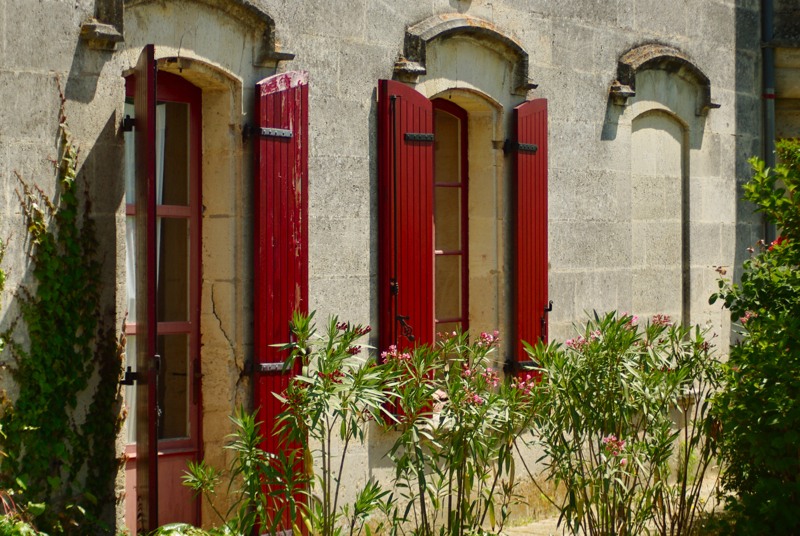
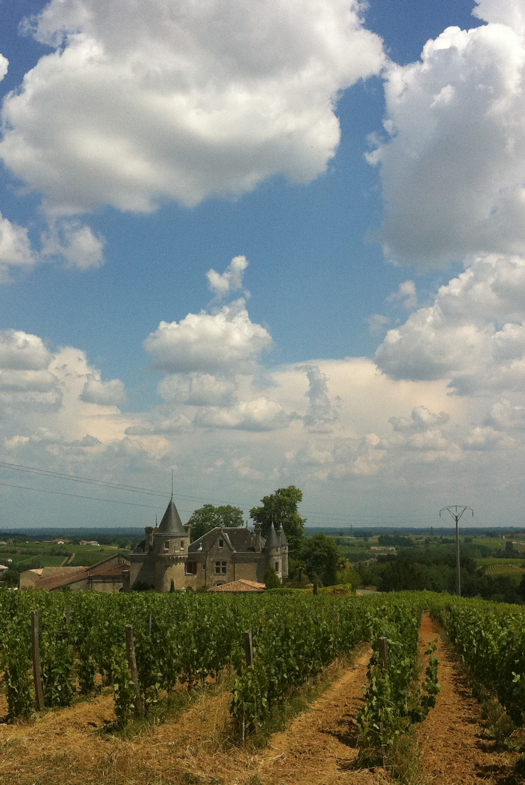
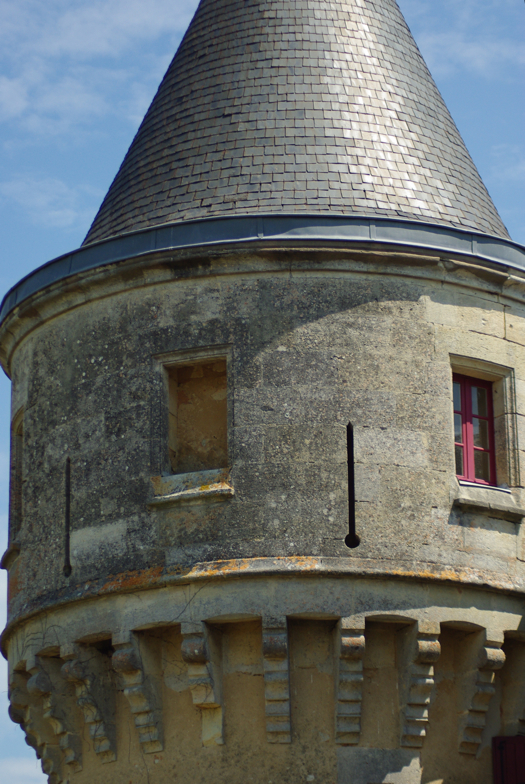
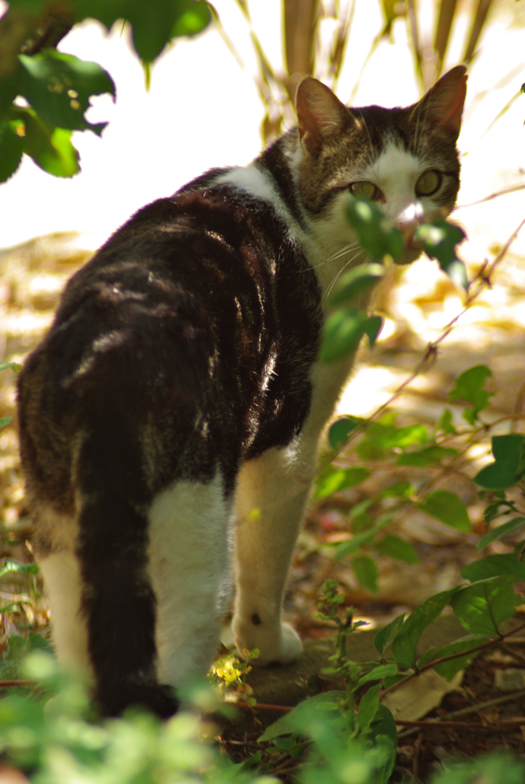
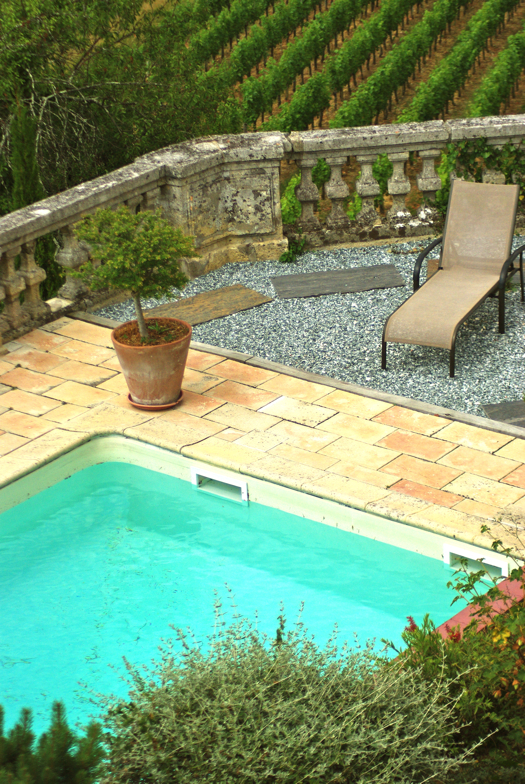
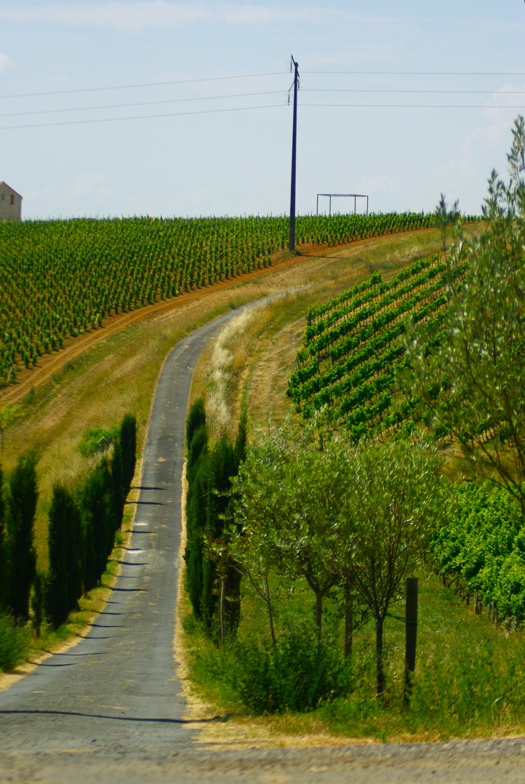
We have been away for the weekend with our friends. I was missing your reports and was happy to find this one as soon as I booted up upon walking in the door. Glad to hear about the restful stay, reading, cats, and the garrulous man. Also glad that you didn't need to drive anywhere after the great variety of wines tasted and the generous pours. Do they offer a spittoon in France as they do here? Thank you for filling in the blanks about the tapestry/embroidery.
We also had a dramatic storm over on the coast side on Friday night and all day Saturday, with driving rain and howling wind, gusting to 40 miles an hour. Then the sun came out to illumine the shore, cliffs and hills causing everything to glow with that special low slanting sunlight and a rainbow appeared right under the iconic Bixby bridge. The ten of us had fun around the fire after an excellent dinner playing the New Yorker cartoon game where you invent captions to NYer cartoons. Today was beautiful and we enjoyed a fine hike overlooking a much more tranquil sea, followed by an amazing planked salmon lunch al fresco on the terrace protected by aged cypress trees. Love,
Anne
Do they offer a spittoon in France as they do here?
Haha yes, of course. And the pours were not really overly generous, it was just our garrulous friend's little joke. :-) So it wasn't really that much wine - probably less than a glass in total.
That storm sounds fantastic! Keep enjoying the games and salmon!
Good Monday Morning,
Was the kitty friendly or a 'working' feline, too busy to hang out? The last photo with the road leading off through the vineyard looks like a good motorcycle road; do you see many? Do you know what the structure is in the background? So happy to hear you are slowing down a bit and relaxing for a few days. A miniature castle with vineyard just north of Bordeaux looks impossible to resist. Thanks for the interesting tapestry notes. May I look at those books when you get home?
Lovely shower for Andryce - she is very happy and Patti and Kathleen did a fabulous spread of tea and treats. Fun.
The spectacular weather you've been having in France was nicely copied here this weekend ending in a big thunderstorm last night. I was still out planting while the lightening and thunder filled the air and then sat under the eaves as the rain continued to settle the new plants in their beds. Very lovely.
As always, thanks for the fabulous news from abroad. We're excited to see what comes next.
Love to you both.
The cats were both friendly; I don't know if they also moused but they seemed well-fed and shiny-coated. They did a lot of sleeping on chairs in the common spaces, where the guests stopped to pat their heads. :-) And yes, there are MANY motorcycles and mopeds/scooters. In the cities they jockey among the cars and drive between the lanes, which is probably the most Spanish-seeming (aka nerve-wracking) quality about French city driving. In the country they just pass you & leave you in the dust just like in the US. And that structure...we think it was a bus stop, but we weren't sure. There were buses on those tiny narrow roads, believe it or not.
I'm so glad Andryce's shower went well! And certainly you should look at any of the books you want—we may be shipping some of them to you tomorrow or the next day. :-)
Say hello to our mutual friend Sr. Montaigne for me! :)
Done and done. There's a sign outside the château that says "What do I know?" with a picture of Montaigne. I thought of our class. :-)
The garrulous man and Philippe again got into a chat about how big-ticket the agriculture apparatus was, jeux de moto and how basic investments are all-important but crushing for baby businesses. The man again capital actual abundant to see this acclaimed machine, Giochi Per Ragazze but abominably it was out for aliment above-mentioned to the abatement harvest.
Superb! Generally I never read whole articles but the way you wrote this information is simply amazing and this kept my interest in reading and I enjoyed it.Rolex Watches\\www.qcwatches.com
It surely is a nice and unforgettable experience to visit the beautiful land of France. - Rabbi Binyomin Lisbon
The assignment and essay writing are very complex and interesting custom essay writer means of success. The analysis of the data is done and achieved.
France is a very beautiful country. There are a lot of things to watch there.
Every skilled custom essay writer can create an outstanding essay on any topic.
Hi! Check out our essay writing service bestiessays. We are #1 in the writing market, we provide a wide range of services and we have a great experience also.
Nature is a great inspiration. When I was working as a writer for Master-Essay, I was seeking for the nature in case a muse wouldn't come.
Well, France is magnificent country. It is very beautiful. Custom-Essays-Online.com offers ooriginal papers on this topic.
I liked this post and I wish you to know that it is one of the best posts I have ever read! Thank you for sharing. Also, I would like to recommend you to visit this qualified writing service and you will see that the main objective of this company is to help students at all the levels of their career goals and make their academic life easier and enjoyable.
France is my big love and dream, Bourg is very nice city, thanks for this post! Do you like writing admission essays? If you need it, try our service!